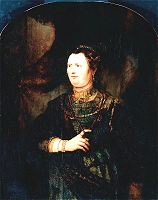 click to enlarge |
PORTRAIT OF A WOMAN Studio of Rembrandt Van Rijn SN 253, oil on panel, early 1650s From "The Pages" |
ARTIST:
Rembrandt was painter, etcher, and draftsman…his country’s greatest artist. Born in Leiden, he studied at a Latin school and a few months in University before leaving to study painting. His most influential teacher was Pieter Lastman (c1624), with whom he spent 6 months in Amsterdam; from him he took not only his predilection for mythologic and religious subjects, but also his manner of treating them with dramatic gestures & expressions, vivid lighting effects, and a meticulous glossy finish. By 1625 he was working as an independent master in Leiden. It was the busiest period of his life, as he quickly established himself as the leading portraitist in the city.
The most important work from this time is The Anatomy Lesson of Dr. Tulp, which brought a whole new vitality to the group portrait.
Rembrandt’s success in the 1630s was personal as well. 1634 he married Saskia van Uylenburch; his tender portraits of her reflect a blissful union, but their happiness was marred by a succession of infant deaths. Of their 4 children, only Titus (1641-68) lived longer than 2 months. Saskia herself died in 1642, the year Rembrandt painted his most famous picture, the misnamed Night Watch, the culminating work of the Dutch tradition of civic guard portraits (a genre particularly associated with Frans Hals). In spite of a 19th c story regarding the clients’ dissatisfaction, evidence suggests this picture was well received.
Although portraits and religious works bulk largest in his output, he made highly original contributions to other genres, including still life. And he painted some - such as The Polish Rider – which defy classification.
Nevertheless, in the 1640s Rembrandt’s life did take a downward turn. He concentrated more on religious and landscape pieces, and his style grew more introspective. There were domestic problems, too. Geertge Dircx, a widow employed as nanny to Titus, sued Rembrandt for breach of promise after his affections turned to Hendrickje Stoffels, a servant some twenty years his junior. Unpleasant legal proceedings ended with Geertge’s remand to an asylum. Because of a clause in Saskia’s will, Rembrandt was unable to marry Hendrickje, but they were together the rest of her life, and she bore him two children. (A daughter, Cornelia, born in 1654, was the only child to outlive him.) Financial difficulties, too, led to the sale of his beautiful home and his collections; in 1660 he moved to a poorer district. Although his final years were saddened by the deaths of both Titus and Hendrickje, Rembrandt continued to be respected, and worked till the end. He faced life with dignity, neither disillusioned nor bitter.
SUBJECT:
The sitter is a woman who presents a solid, masterful presence with glowing, heavy flesh and gleaming bracelets. Her dress is neither contemporary nor classical; perhaps she represents a character in the tragedy by Joost von den Vondel, Gysbrecht van Aemstel, which was popular in 1617. In this hypothesis, the lady may be a portrayal of Gybrecht’s wife, Badeloch.
PAINTING:
There are two butterfly cleats in the work, one at the bottom, one behind the right eye. The suggestion is that they were used to join the panel in preparation for painting, which was not uncommon in the 17th c. Over the years the back of the painting was “cradled,” i.e., a crisscross of wooden strips were added to prevent warp. Wooden panel gives a whole different luminosity than canvas. Considerable controversy surrounds the attribution. All techniques used by Rembrandt are present, but there has been overpainting, restoration, and damage to a degree which prevents accurate conclusions.